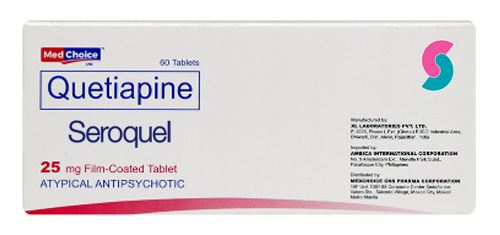Buy Seroquel (Quetiapine) online at the best price without a prescription

| Product Name: | Seroquel (Quetiapine) |
|---|---|
| Doses: | 25mg, 50mg, 100mg, 200mg, 300mg |
| Prices: | $0.60 – Per Pill |
| Where To Buy Online | OnlinePharmacy |
Seroquel, known as Quetiapine, is an antipsychotic medication used primarily for managing mood disorders. It belongs to a group of medications called atypical antipsychotics. Seroquel operates by modulating the levels of neurotransmitters, specifically serotonin and dopamine, in the brain, which are crucial in the regulation of mood and behavior.
Developed and marketed by AstraZeneca, Seroquel has been a vital tool in the psychiatric therapeutic arsenal since its FDA approval. It's known for its effectiveness in controlling the debilitating symptoms of psychiatric conditions, thereby improving patient outcomes significantly.
As with any medication, the journey of Seroquel from its development, approval, and widespread clinical use has been marked by continuous research and observation, leading to a deeper understanding of its benefits and risks.
Despite its effectiveness, Seroquel is not without controversy, especially concerning its side effects and the management of off-label uses. Nonetheless, it remains a critical component of psychiatric treatment for many individuals.
Understanding what Seroquel is and how it works is the first step in understanding its role in treatment regimens for various mental health disorders.
What is Seroquel used for?
Seroquel is used primarily to treat several psychiatric conditions, most notably schizophrenia, bipolar disorder, and major depressive disorder as part of combination therapy. It helps manage the hallucinations, delusions, mood swings, and depression that can accompany these conditions.
For schizophrenia, it can reduce or eliminate positive symptoms like hallucinations and delusions, and help with negative symptoms such as social withdrawal and apathy. In the context of bipolar disorder, it can stabilize mood swings and reduce the risk of both manic and depressive episodes.
While it's not a cure for these conditions, Seroquel can significantly improve quality of life for many patients. Its use must be carefully managed and combined with other forms of therapy, such as psychotherapy and social support, for maximum effectiveness.
Additionally, off-label uses of Seroquel include treatment of anxiety disorders, insomnia, and other conditions as deemed appropriate by a healthcare provider. However, these uses are less common and require careful consideration of the benefits and risks.
Understanding the uses of Seroquel provides insight into its role in modern psychiatric care and the lives of those it helps.
What Dosages and Forms is Seroquel available in?
Seroquel, known by its generic name quetiapine, is available in several dosages and forms. The dosages generally depend on the condition being treated and the patient's response to the medication. It's important to note that only a healthcare professional can determine the appropriate dosage. The common forms and dosages of Seroquel include:
- Immediate-Release Tablets: Available in dosages of 25 mg, 50 mg, 100 mg, 200 mg, 300 mg, and 400 mg. These are typically taken two or three times a day.
- Extended-Release Tablets (Seroquel XR): Available in dosages of 50 mg, 150 mg, 200 mg, 300 mg, and 400 mg. These are taken once daily, often at bedtime.
The specific dosage and form of Seroquel prescribed can vary based on the condition being treated. For example, lower dosages are often used for treating conditions like bipolar disorder or depression, while higher dosages may be prescribed for schizophrenia. It's crucial to follow the prescribing healthcare professional's instructions and not to alter or stop the medication without consulting them.
How to take Seroquel?
Taking Seroquel correctly is crucial for its effectiveness and safety. It's typically taken one to three times a day, with or without food. The extended-release tablets should be swallowed whole and not split, chewed, or crushed.
It's important to follow the dosing schedule prescribed by the healthcare provider closely and not to alter or discontinue the medication without professional guidance. Sudden changes can lead to worsening of symptoms or withdrawal effects.
Consistency is key; taking Seroquel at the same time each day helps maintain stable levels of the medication in the body. It's also essential to communicate with the healthcare provider about all other medications being taken to avoid harmful interactions.
Seroquel (Quetiapine) is prescribed for various conditions, and its administration depends on the specific ailment being treated. Here's a more detailed look at the dosing guidelines:
For Bipolar Disorder Depression:
- Adults: Initially, 50 mg once daily in the evening, not exceeding 300 mg/day.
- Children: Dose determined by the doctor.
For Mania in Bipolar Disorder:
- Adults: Start with 300 mg once daily in the evening, maximum 800 mg/day.
- Children (10-17 years): Begin with 50 mg daily in the evening, up to 600 mg/day.
For Major Depressive Disorder (MDD):
- Adults: Start with 50 mg once daily in the evening, not exceeding 300 mg/day.
- Children: Dose determined by the doctor.
For Schizophrenia:
- Adults: Begin with 300 mg once daily in the evening, maximum 800 mg/day.
- Children (13-17 years): Start with 50 mg daily in the evening, up to 800 mg/day.
Dosing for the regular oral tablets varies slightly and includes different initial dosages for bipolar disorder and schizophrenia. In case of a missed dose, take it as soon as possible but skip it if it's nearly time for your next dose. Do not double doses.
How long does it take for Seroquel to work?
The time it takes for Seroquel to work can vary significantly from person to person. In general, some improvement in sleep, appetite, and overall mood may be noticed within the first 1-2 weeks of starting treatment. However, it may take several weeks to see the full therapeutic effects, especially for conditions like depression and bipolar disorder.
For acute manic or mixed episodes in bipolar disorder, some patients may notice improvements in symptoms within 4-7 days, but the full benefit might not be evident until several weeks of treatment.
In schizophrenia, symptom improvement can also be gradual, with incremental benefits accumulating over weeks to months. Patience is crucial, as premature changes or discontinuation of treatment can lead to relapse or worsening of symptoms.
It's important for patients to maintain open communication with their healthcare provider about their progress and any side effects they experience. This allows for timely adjustments to the treatment plan if needed.
Understanding the expected timeline for Seroquel's effects can help patients and caregivers maintain realistic expectations and stay committed to the treatment plan.
How long does Seroquel last?
The duration of Seroquel's effects depends on several factors, including the specific dosage, the individual's metabolism, and the form of the medication taken (immediate vs. extended-release).
Immediate-release Seroquel typically has a shorter duration of action, necessitating multiple doses throughout the day to maintain stable levels of the medication in the body. In contrast, the extended-release version is designed to be taken once daily, providing a more consistent effect over a longer period.
The half-life of Seroquel, or the time it takes for half of the drug to be eliminated from the body, is approximately 6 hours for the immediate-release formulation. This means that it's generally out of the system in about a day or two, although this can vary between individuals.
For the extended-release version, the half-life is slightly longer, leading to a more prolonged effect. Regardless of the formulation, consistent dosing is essential to maintain the therapeutic effects and avoid withdrawal symptoms.
Patients should discuss the expected duration of effect and any concerns about timing or scheduling of doses with their healthcare provider to ensure optimal management of their condition.
Seroquel possible side effects
Seroquel, like all medications, can cause side effects, some of which may be serious. Common side effects include drowsiness, dizziness, dry mouth, constipation, and weight gain. Some people may also experience changes in blood sugar and lipid levels, which can require monitoring and management.
More serious side effects can include extrapyramidal symptoms (such as restlessness or tremors), tardive dyskinesia (a movement disorder), and an increased risk of stroke, particularly in elderly patients with dementia-related psychosis.
One of the most severe potential side effects is neuroleptic malignant syndrome, a rare but serious condition that can lead to high fever, muscle rigidity, and altered mental status. If suspected, this requires immediate medical attention.
It's also important to be aware of the potential for metabolic changes, including weight gain, increased blood sugar, and cholesterol, which can lead to or exacerbate existing diabetes or cardiovascular disease.
Patients should be well informed about the potential side effects of Seroquel and report any unusual symptoms or concerns to their healthcare provider promptly. Regular monitoring and communication are key to safely managing side effects and maintaining overall health.
Seroquel Patient Experiences and Reviews
Patient experiences with Seroquel vary widely, reflecting the diversity of conditions it treats and the individual differences in response to medication. Many patients report significant improvements in symptoms of psychosis, mood stability, and overall quality of life.
On the positive side, patients often note the relief from the distressing symptoms of schizophrenia or the extreme mood swings associated with bipolar disorder. For some, Seroquel has been life-changing, allowing for greater engagement in personal and professional activities.
However, not all experiences are positive. Some patients report challenging side effects, such as significant weight gain, sedation, or feelings of numbness or detachment. These side effects can lead to non-compliance or discontinuation of the medication.
Online forums and review sites provide a platform for patients to share their stories and connect with others facing similar challenges. While these can be valuable resources, it's important to remember that personal experiences vary greatly, and what works for one person may not work for another.
Understanding the range of patient experiences can provide valuable insight into the real-world effects of Seroquel, but decisions about its use should always be made in consultation with a healthcare professional.
Does Seroquel improve the quality of life?
The impact of Seroquel on quality of life is a critical consideration in its use. For many individuals with severe psychiatric conditions, Seroquel can lead to a significant improvement in symptoms and, by extension, a better quality of life. The ability to manage hallucinations, delusions, or severe mood swings can be life-changing.
However, the improvement in quality of life must be balanced with the potential for side effects. Weight gain, metabolic changes, and other adverse effects can negatively impact physical health and well-being, leading to new or worsened health concerns.
Moreover, the benefits of Seroquel can vary widely between individuals. Some may find it highly effective, while others may not respond as well or may experience intolerable side effects.
Therefore, the decision to use Seroquel should be made on an individual basis, considering all the potential benefits and risks. Ongoing communication with a healthcare provider, regular monitoring, and adjustments to the treatment plan as needed are essential to maximizing the quality of life while minimizing the risks.
Seroquel has the potential to improve the quality of life for many individuals, but like any medication, it must be used judiciously and with careful consideration of the individual patient's needs and circumstances.


